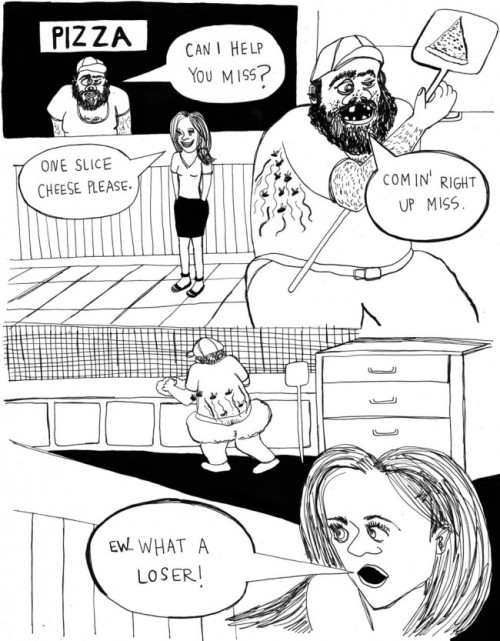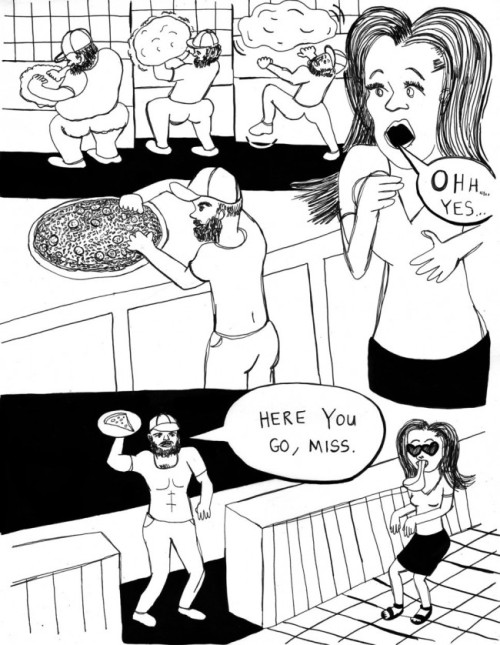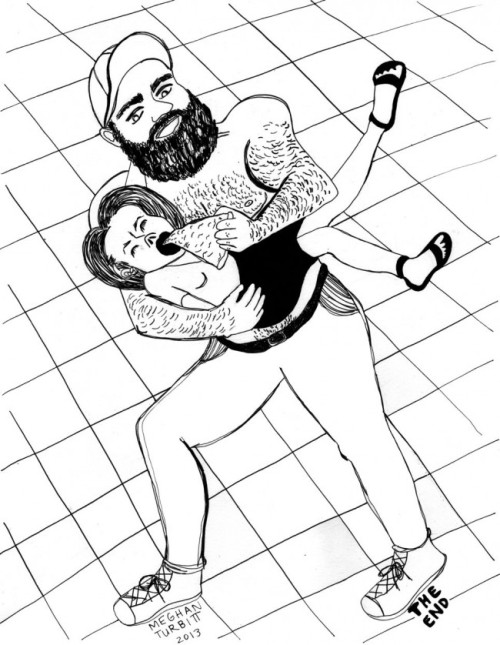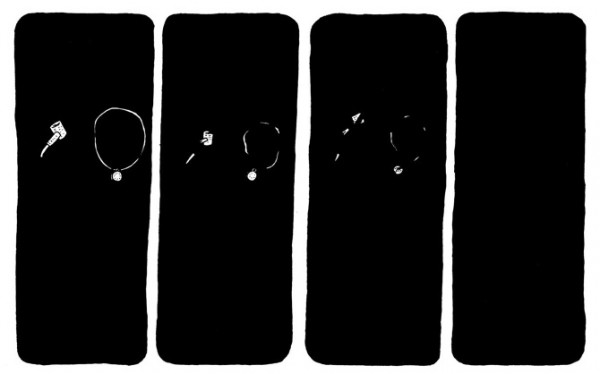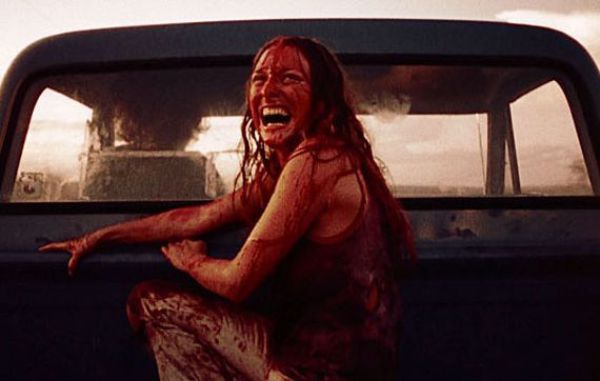Archive for August 25, 2014
Say Hello, Meghan Turbitt!
August 25, 2014I’m particularly interested in the idea advanced in Sophia Wiedeman’s piece on you and Katie Skelly for The Rumpus that your work is driven in part by Catholic guilt. Certainly your comics seem to revel in a rejection of Catholic mores, but more than that, they don’t smooth out the rough edges to make the violation more palatable, you know? The sex is, frankly, gross, and so is the food component, once that’s introduced in #foodporn.There’s not an attempt to play respectability politics with it.
Everything I make, every particle of my being, is based on how I grew up. Everything I make will of course be influenced by that. But to be honest, the reason I made #foodporn is because I had a crush on an ugly guy who made pizza at my local pizza joint. He is not attractive. When he was making the pizza I was attracted to him, though? I didn’t understand it and I couldn’t stop thinking about it. I thought the concept of him getting hotter and hotter as he made the pizza was just hilarious. Hence the premise of the book.
Oh, just an interesting piece of side trivia – I finally did end up having sex with him, two days after #foodporn was released at MoCCA. I’ve stopped eating pizza since.
Typically when comics creators talk about essentially willing something from one of their comics into existence, it’s, like, Grant Morrison talking about tripping in Nepal or whatever and discovering the true nature of space-time. This is somewhat more relatable. But if it put you off pizza, then I wonder if in retrospect you’d have preferred it to have remained a fantasy.
Very interesting to me that you use the word “fantasy.” In March, I got out of an eight-year relationship. We had broken up and I moved out in 2012, but we ended up getting back together very quickly. But over the last year I had several crushes on people, especially this pizza guy, and I ended up making the comic about him. Things were just not working out with my ex, even though I loved him very much and he was family to me. I spent a lot of time fantasizing about “what life would be like” with certain other people, and this pizza guy was first in line. However, I didn’t make any moves about ending the relationship for almost a year after making the comic about him. My therapist had a real woman-to-woman conversation with me, knocked some sense into me, and suggested to me that my life might actually be greater on the other side of ending things with my ex, so I did it. For some reason at that moment it hit me that my life might be better with my ex not in it, which seemed almost unfathomable to me. She was right. So I guess one could say, therapist Sean, that maybe I avoided one of those painful Irish-Catholic illnesses or avoidance-of-feelings situations here? Perhaps history did not repeat itself, hmmm?
Luckily, things with this pizza guy fell into place — I got drunk at the pizza place and propositioned him — and we saw each other for a little while. It certainly served a purpose and helped me get through my breakup. I suddenly felt sexy again. He knew about my comic about him, and about #foodporn. He was aware I was doing some podcast interviews and being reviewed, and the comic about him was mentioned a few times. One night, in the midst of all this, he told me that he had gone to my website and looked at my comics, and told me, “Wow, I thought you were going to be much more famous than just this.” He also referenced myConancomic, in which there is a long sex scene between me and Conan O’Brien, while we were having sex one night, which I thought was hysterical, and which I am currently making a comic about now.
Anyway, this pizza guy was into Phish, and if anyone knows me they know I’m not into jam bands, so it just wasn’t meant to be — even though I continued to draw him and make comics about him while we were seeing each other. I guess I was just looking for anyone who wasn’t my ex and was fascinated by that. A few months after we started seeing each other, my friend Holly caught him arm in arm with another chick around the corner from my house. She went into the pizza place, which we frequented regularly, the next day and called him out in front of all of his coworkers. Needless to say, we haven’t really been back there since. So my ultimate curse is that I live half a block away from a pizza place that I love and can’t go to. So fantasy, shame on me I guess. All around, it’s been a fascinating chain of events for me to witness go down. And now I’ll have #foodporn to document it for the rest of my life, so “LOL,” I guess.
“The Leftovers” Thoughts, Season One, Episode Nine: “The Garveys at Their Best”
August 25, 2014You never forget where you were when it happened. They say it’s true of all tragedies, and they may be right. The Leftovers, it turns out, is not going to take any chances. Tonight’s thoroughly harrowing episode — titled, with cruel irony, “The Garveys at Their Best” — is an hour-long flashback covering approximately one 24-hour period in October, three years ago: from the morning of the day before the Sudden Departure to the first moments after it happens. And as an act of storytelling, it’s tear-down-the-sky shit. We never actually watch anyone Depart – the camera is always pointed elsewhere – but that is the show’s sole nod to modesty. From the moment you hear Nora Durst’s children say “Mommy! Mommy! Mommy!” to our discovery of just how catastrophically the Departure hit Kevin and Laurie Garvey, every ounce of grief, fear and sadness will be left exposed.
“The Leftovers” thoughts, Season One, Episode Eight: “Cairo”
August 18, 2014But it’s not just the actual life-or-death stakes of Patti’s plight that [director Michelle] MacLaren wrings for every ounce of tension and pathos. Jill Garvey grilling Nora Durst about her gun over dinner. Meg needling Laurie while breaking her vow of silence. Jill and her friend Aimee getting meaner and meaner to each other in a game of emotional chicken that Aimee eventually loses. The wordless sequences in which the Guilty Remnant prepare their big Memorial Day stunt. The climactic moment where Jill reunites with her mother in order to join her cult. “Cairo” was all about turning the screw until someone, anyone yelled “Jesus Christ, enough!”
Which is to say, yeah, it’s a pretty grim hour of television. A woman gives a lengthy monologue about how love has to be left behind, then slits her own throat – how could it not be dark? But it’s by no means a humorless, bleakness-über-alles episode. The twin bros played by Max and Charlie Carver remain 2014’s great casting coup; everything you need to know about them you could learn from the way the one dude finds a bulletproof vest and says “Jackpot!” Little moments of worldbuilding also break the tension, like the increasingly obvious fact that in the post-Departure universe, marijuana is legal enough to smoke in a public park full of frolicking kids. Even Patti gets in a few good one-liners, like the one where she responds to Dean’s pompous proclamation that he’s a “guardian angel” with “Well, shit, I think I just heard a bell ring.”
It’s also pretty profoundly insightful about how people process pain, or don’t. The after-dinner exchange Kevin and Nora have about Jill (“It’ll get better.” “How?” “I don’t know. But it will.”) is basically the mantra of anyone clear-eyed enough to acknowledge that things are shitty, but optimistic enough to believe they won’t stay that way forever. Later, Aimee takes this philosophy and weaponizes it, taunting her sad-sack, soon-to-be former friend by sarcastically saying “Just so you know, it is possible for some people to be okay.”
Elsewhere, if Meg’s berserk reaction to his flyers about her late mother wasn’t already indication enough, Reverend Matt clearly has her number. “Her grief was hijacked,” he says, and that’s a good way to understand the Guilty Remnant: If the Sudden Departure stole everyone’s ability to really focus their pain, they’re stealing it back. “I think about it every fucking waking moment,” Patti says of humanity’s greatest trauma. “I mean, come on. What else is there to think about.” The GR are forcing everyone to think about it, as directly and obnoxiously as possible. It’s trolling as religion.
The Leftovers has gotten consistent and creative, and last night’s episode was no exception. I reviewed it for Rolling Stone.
Ferguson
August 14, 2014Since last December I’ve kept a garish looking tumblr called Badge, located at beforetheybringthecurtaindown, where I aggregate incidents of police brutality and overreach. Sometimes I’ve kept up with the countless stories of aggression, abuse, murder. Other times I’ve let it slide. But they’re always there. Alway someone dying in a holding cell, wounded in a no-knock raid, harassed for reporting or protesting, having their dog killed, getting arrested and assaulted for not instantly obeying. It’s out of control everywhere, but it’s mostly black people getting murdered by the people whose job it is to protect and serve them.
I used the lyric “before they bring the curtain down” for my URL because you could tell the curtain was coming. After all, coordinated, nationwide, violent “law enforcement” action crushed a nonviolent protest movement in America, Occupy, just a couple years ago. Ferguson is just the place unlukcy enough where the two trends — abuse of minorities and abuse of dissenters — converge. Ferguson’s where they bring the curtain down.
Once you’ve created the conditions for force to be used, it will DEFINITIONALLY be wielded on those least equipped to defend against it. The subaltern, the underclass, the civilians, the noncombatants, the women, the children. With “war on drugs”/”war on terror” rhetoric, domestic availability of military weapons and tactics, and “keep us safe” fetishization, we dug a riverbed. When the water starts flowing, it flows downhill.
Comics Time: Alien Invasion III
August 14, 2014True, in a way, to its title, Lauren “Lala” Albert’s Alien Invasion III has two primary concerns: aliens and invasiveness. The former are presented in the fashion that has become Albert’s trademark as an artist working with science-fictional imagery in an underground context — otherworldly and elfin, their ubiquitous third eyes a collective locus of mystical enlightenment, erotic fascination, and viscous physicality all at once. The invasions are varied. Aliens visit Earth, humans visit other worlds, humans and aliens travel between worlds together. Alien biology is probed by a human performing an autopsy, explored by two aliens in a body-modification ritual with romantic undertones, inserted unexpectedly and forcibly into an unsuspecting human’s more familiar body. In all four cases the theme is intimacy, invited or not.
I reviewed Alien Invasion III by Lauren Albert (aka Lala Albert) for The Comics Journal.
How Teenage Mutant Ninja Turtles went from comics in-joke to cowabunga blockbuster
August 14, 2014Most of the action-figure/kids’-cartoon juggernauts of the Eighties were developed the old-fashioned way: by corporations. He-Man and the Masters of the Universe began in the design department of toy behemoth Mattel. Its rival Hasbro teamed up with Marvel Comics to revive its old G.I. Joe concept, this time making its toy soldiers the same size as the smash-hit Star Wars action figures to which Mattel had passed up the rights several years earlier, with their “Real American Hero” relaunch. The Hasbro/Marvel team-up found similar success when it rebranded several lines of robot toys Hasbro had licensed from Japanese toy company Takara as the Transformers.
By contrast, the Turtles literally started out as a joke. Co-creators Kevin Eastman and Peter Laird were comic-artist wannabes when they spent a November 1983 evening doodling the masked, weaponized reptiles to entertain themselves. Each adjective in Turtles‘ title represented a hot superhero-comic trend at the time — mutants were the stars of Marvel’s Uncanny X-Men; DC’s New Teen Titans had teenage protagonists; and future Sin City impresario Frank Miller had stuffed his groundbreaking run on Daredevil full of ninjas. By throwing it all together atop a funny-animal framework — which, from Carl Barks’ Donald Duck to Steve Gerber’s Howard the Duck, had long been a route to comic-book gold — Eastman and Laird simply obeyed the Spinal Tap doctrine of cranking it to eleven.
This here is a snippet from the history of the Teenage Mutant Ninja Turtles I wrote for Rolling Stone. The gist is that the Turtles began as a literal joke shared by creators Kevin Eastman and Peter Laird, and came to prominence as a comic that existed halfway between Frank Miller parody and Frank Miller homage; it was only when Eastman & Laird hooked up with a toy company that hooked up with an animation studio — i.e. the same basic process that birthed He-Man, G.I. Joe, and the Transformers — that it became the durable pop-culture phenomenon it is today.
I got to work in all kinds of fun factoids — the “black-and-white boom” that followed TMNT’s success in comic shops, the bonafide alternative-comics ventures funded by Eastman (Tundra) and Laird (the Xeric Grant) with their Turtle fortunes, “Turtle Power” going to the top of the pop charts in the UK. I hope you enjoy it!
“The Leftovers” thoughts, Season One, Episode Seven: “Solace for Tired Feet”
August 11, 2014Putting prurient interests aside, the now-physical relationship between Chief Kevin Garvey and local survivor-celebrity Nora Durst deserves top billing. After all, it’s the softest plot thread in the show’s narrative tapestry, a rare display of human connection and kindness that’s not undermined by grief and guilt, or corrupted by attempts to harness those emotions to some grand ideological purpose. You want these two crazy mixed-up kids to fall for each other, because after what they’ve been through, they deserve it.
The show fuels our attachment to their attachment several times. Nora’s given the episode’s most purely cathartic moment when she turns the garden hose on the Guilty Remnant, in particular Liv Tyler’s sanctimonious new convert Meg. (Meg is rejected a second time when she narcs on the tryst to Kevin’s ex-wife Laurie, who seems just as turned off by her nosing around as we are.) And after an episode spent hiding or denying his mental deterioration, Kevin reveals his fear that he’s following in his schizophrenic father’s footsteps as part of pillow talk. Their actual sex may have been edited in an arrhythmic fashion that suggested Kevin viewed it as some kind of out-of-body experience, but afterwards, he’s comfortable enough with Nora to share his darkest secret. Forget Kevin Sr.’s cryptic messages – that intimacy and ability to connect with someone once more is the sign Kevin Jr. should pay attention to.
I really like good sex scenes on TV dramas; watching beautiful people do convincingly hot things with each other is one of the medium’s great pleasures. I wrote about that and a lot of other little things that made last night’s episode of The Leftovers pretty good for Rolling Stone.
Comics Time: Danny Boy
August 8, 2014…the ending is otherwise the strongest section of the comic, the one place where Danny Boy takes on a life of its own. It does so in death. In the end, father and son are buried side by side, first their bones and then even their coffins breaking down as the dark earth reclaims them. In the end, the totemistic pipe and locket that Faret had used as shorthand for each member of the pair are all that remain, and they too are disintegrated and consumed before the final black panel. A realist might question the staying power of a corncob pipe in a grave, while a reader partial to extremes might miss a full-fledged depiction of dead bodies rotting away into nothingness (admittedly this is where my sympathies lie), but both critiques are superfluous to the sequence’s purpose, if not its power. In these final pages, Faret unearths an unspoken element of “Danny Boy” and puts it on display: The song’s final line is “And I shall sleep in peace until you come to me,” but of course at that point in the song the child has already returned, is in fact kneeling on the grave. It’s death the parent is looking forward to sharing with his child, because only then will their reunion be complete. Faret shows what that would look like, taking the original and adding a stanza of her own.
Those final pages present a potentially rewarding path for Faret to follow as an interpreter of existing stories. It reflects the same sensibility on display in, say, her luminous, horror-tinged scratchboardillustrations for Arthur Miller’s The Crucible. Though the whole point of Miller’s witch-hunt parable is that the thing was bunkum, Faret casts her cast of goodwives in a seemingly supernatural light, suggesting that terrible forces and tremendous powers were in play here — just not in the way the persecutors believed. Neither here nor in the end of Danny Boy is Faret indulging in the aforementioned glurge, lacing contemporary mores into past events in order to make readers feel good about their unearned ethical superiority (though she’s not entirely immune to this temptation); rather, she’s tapping into ideas and sentiments present in the characters and giving them freedom to manifest themselves in ways the characters could never do. Danny Boy may be a failed experiment, but in conducting it Faret has collected data that could well yield happier results a season or two down the line.
I reviewed Danny Boy by Kjersti Faret for The Comics Journal.
Marilyn Burns 1949-2014
August 6, 2014“Halt and Catch Fire” thoughts, Season One, Episode Ten: “1984”
August 4, 2014The final Halt and Catch Fire of Season One begins with the show’s single most likeable sequence: Things are tense in the Clark household, where Gordon and Donna have evidently not recovered from the COMDEX debacle. Dishes are washed, beers are drunk, TV is watched, all joylessly, silently. Finally, Gordon attempts to settle in on the couch where he’s been sleeping – but Donna has had enough. “Get in there!” she demands, directing Gordon to the bedroom she insists she’ll be sharing with him tonight. “I’m still very mad at you,” he replies, pointing at her, and surrendering. She giggles. They walk off to bed, Gordon stomping and swinging in faux-fury. The two of them have decided that their fight about Donna’s borderline infidelity and Gordon’s job-related neglect was about real issues – ones that pale in comparison to the even realer love and respect they share. As Donna puts it in code later in the episode, when Gordon presents her with the engagement-slash-decoder ring he promised her nine years back, “I darf you very gerp.”
The Gordon-Donna scenes in this late-blooming show’s season finale — ‘1984” — aren’t just the show’s most human moments to date. They echo the legendary Apple Super Bowl ad that gives the episode its title, and like the Cameron lookalike who smashes the oppressive IBM machine in that commercial, they represent the triumph of imagination, emotion, and empathy over cold hard calculation. Gone is the Halt that forced its characters into empty confrontations week in and week out to drum up drama on the cheap – the equivalent of the Cardiff Giant’s faster-cheaper computing model. In its place? A handsome, clean-shaven, confident, self-actualized Gordon, now head of the company where he was once just another face in the crowd. But more importantly, he’s a Gordon we actually give a shit about.
Much to my surprise, Halt and Catch Fire wound up being a pleasurable, emotionally sticky show — and it’s the rare prestige drama in which the women are happier and more fulfilled than the men. I reviewed its season finale for Rolling Stone.
“The Leftovers” thoughts, Season One, Episode Six: “Guest”
August 4, 2014We also see Nora reject a number of possible paths to closure when she heads to Manhattan for a conference on Departure-related industries. This begins when a bro-tastic bereavement specialist — the one who works for the company that makes “Loved Ones” simulacra of departed family members for burials or cremations — comes on to her. She enjoys his hospitality suite and his attentions, admitting he’s not the soulless creep he might seem, and still chooses to make out with his real-doll doppelganger rather than the genuine douchebag article. Watching Nora writhe atop the mannequin is the series’ sexiest moment to date, and no wonder – here’s a person deriving an erotic charge from the very concept of closure, making a public show of pleasure out of something intended to be a private totem of grief.
Next, she blows up the spot of the activist/conspiracy theorist who impersonates her at the convention, and appears to blow off her warnings about the Department of Sudden Departures. That’s harder for the audience to do, of course; when she warns that the DSD’s “questionnaires are sent to incinerators outside of Tallahassee, Florida,” we know that the government’s burning much worse things than that. But she’s even harder on Patrick Johansen, the conference’s star attraction and author of What Comes Next, a self-help book for “legacies” of the Departed. Calling him a fraud who’s faking his grief, she drunkenly screams at him “What’s next? What’s fucking next? Nothing is next! Nothing!”
It’s this nihilism that attracts Holy Wayne’s acolyte to Nora. He knows she’s right about Johansen, because the writer didn’t work through his grief at all – he had it magically sucked out of him. And when Wayne meets Nora, the healer recognizes that she’s not rejecting happiness out of hopelessness, but because she does have hope — and she wants to get rid of it. “If [your pain] starts to slip away, you seek it out again, don’t you?” he asks her, knowing the answer is yes. “Hope. It’s your weakness. You want it gone because you don’t deserve it.” There’s a certain strain of depression that internalizes and personifies misfortune, that sees it as the natural state of things, that sees happiness as fraudulent in the face of the shortcomings the depressed person knows better than anyone. This is as accurate an encapsulation of that kind of depression as a TV show is likely to deliver.

